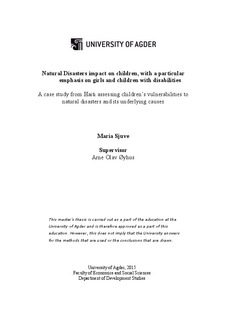| dc.description.abstract | This thesis explores whether children, and especially girls and children with
disabilities, are more vulnerable in natural disasters. In addition, the thesis
investigates what the underlying factors of children’s vulnerabilities are caused by
and how we can decrease their vulnerabilities, using Haiti as a case study.
Disasters poses substantial threat to both sustainable development and poverty
reduction initiatives and can be argued to be the very “antithesis of human
development”. The impacts of natural disasters are not evenly distributed among
countries, neither are the impacts evenly distributed among citizens. Impacts are
determined by factors such as environmental degradation, poverty levels and
location. Social inequalities such as age, gender, class and ethnicity also defines
vulnerabilities to disasters in a given society and children, especially in developing
countries, are extremely vulnerable to the impact of natural disasters. However, little
literature addresses gender inequalities amongst children and children with
disabilities in disasters. This shows that there is a great need for more research into
children’s vulnerabilities and what influences their vulnerabilities.
The analysis in this study indicate that children have specific vulnerabilities simply
because they are children and that girls are more vulnerable because of the
dangerous situation they are placed in, exposing them to abuse and exploitation.
Children with disabilities are the most vulnerable group simply because they are not
being prioritised by neither the government nor the NGOs, not only in disaster
management, but also in development activities overall. Further, a key argument of
this study emphasise that a country’s historical and present context together with the
presence of numerous NGOs contributes to and shapes children’s vulnerabilities.
There is therefore a great need for the Government of Haiti and the NGOs to come
together to develop a comprehensive sustainable development strategy for Haiti,
incorporating general development activities, disaster management and climate
change adaptation. | nb_NO |
